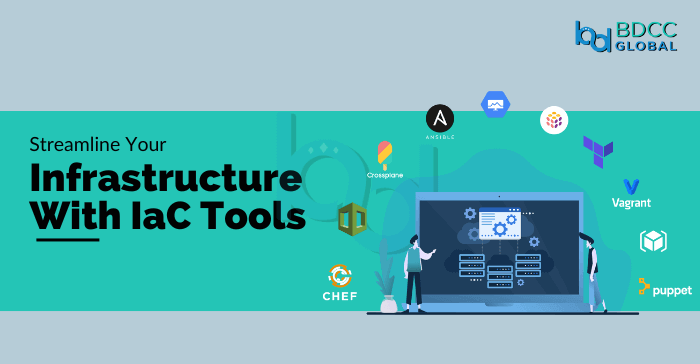
How long does deploying a server or any other infrastructure resource take? Indeed, manual deployments take time and effort to scale! Automation with Infrastructure as Code is the best solution for complex infrastructure deployments.
IaC is an Infrastructure Management Practice through code. It enables automated, reliable, and scalable infrastructure deployment.
IaC is an emerging practice in Agile Software Development that eliminates manual infrastructure provisioning processes. This blog will discuss the most popular tools and best techniques that suit infrastructure environments of all sizes.
Defining Infrastructure-as-Code
Infrastructure-as-Code (IaC) is a technique where infrastructure is described and provisioned using code. IaC has two syntaxes:
- Declarative (It defines the desired state of the system)
- Imperative (It resembles procedures with pre-defined steps to follow)
IaC can ease the burden of configuring cloud resources for separate environments when combined with DevOps pipelines. With Terraform, DevOps teams can save precious hours by eliminating the need for manual resource provisioning via CLIs or GUIs.
Benefits of using Infrastructure as Code Tools
- Improved reliability through rigorous testing and deployment.
- Faster deployment times with automated building, configuring, and deploying infrastructure.
- Increased scalability through programmatic definition and management of resources.
- Better collaboration with version control and IaC tool to automate deployment processes.
- Reduced risk of errors and increased efficiency with automated provisioning.
- Consistency in infrastructure configuration across environments with repeatable code.
- Cost savings through easy scaling and avoiding manual errors.
- Easier recovery from disasters through recreating infrastructure from code.
- Enhanced security through better access control management.
Common Infrastructure as Code Tools
Public cloud providers have released various proprietary and open-source IaC tools due to their popularity. Various third-party tools can also create resources across multiple cloud computing systems. Let’s discuss them individually.
Terraform
HashiCorp Terraform has an open-source declarative syntax to define cloud resources such as VMs, VNETs, Storage, Load Balancers, and Databases. Terraform, being cloud-agnostic, can manage infrastructure on any cloud provider.
Ansible
Ansible is another popular tool that uses simple syntaxes to describe infrastructure. It is agentless, making continuous integration (CI) more accessible and straightforward for DevOps professionals. It does not require any software to be installed on the target machines. Instead, it uses SSH to connect to the machines and execute commands.
Puppet
Puppet is another tool with a similar declarative syntax to define cloud resources. Unlike Ansible, Puppet is agent-based, requiring software installation on a target machine. Puppet’s configuration management capabilities make it an excellent choice for managing complex infrastructure.
Azure Resource Manager (ARM)
ARM is a cloud-specific infrastructure as code tool developed by Microsoft. ARM is tightly integrated with various Azure services. It is applicable only for infrastructure resources on the Azure cloud platform.
AWS CloudFormation
Like ARM, CloudFormation is an AWS cloud-specific tool developed by Amazon. It works with other Amazon Web Services (AWS) hand-in-hand. But, it only supports infrastructure provisioning in other cloud platforms.
Best Practices for IaC Implementation
To ensure that your IaC implementation is successful, follow these best practices:
Version control of code with Modularization
Keep the code into modules that can be reused later across different projects. This can help you to avoid duplicating code with consistency. Additionally, you should version control your code using DevOps pipelines and a version control system like Git. Thus you can track the changes and roll back later.
Deployment Testing
Testing your IaC code in Dev Environment before production deployment is crucial. This can help you catch code errors and ensure your infrastructure stays reliable. You can use Test Kitchen and InSpec to automate Unit and Acceptance Testing.
Collaboration with CI/CD
Integrating IaC into your CI/CD pipeline can help you automate various DevOps processes. Thus you can deploy cloud resources quickly in your infrastructure. Tools like Jenkins, GitLab, and CircleCI perfectly integrate IaC into CI/CD pipelines.
Security Control Management
As Infrastructure Security is a crucial aspect, you can take help from top DevOps consulting companies. The professionals will suggest security regulatory measures like using secure passwords, encrypting sensitive data, etc. Additionally, Chef InSpec is perfect for security testing automation.
Common Challenges in Adopting IaC
- Adopting a new tool for implementation can be challenging for professionals who need more experience in IaC.
- Teams might need help defining the existing infrastructure with code.
- Selecting the right tool for the project can be a challenge.
- Managing complex infrastructure across different clouds can be challenging with declarative IaC.
- The complex integration of IaC code with legacy systems and on-premise infrastructure.
Conclusion: What Can Be The Future Trends in IaC?
Infrastructure as Code is now an essential practice in Agile Software Development. As more companies move to the cloud, the demand for IaC Implementation will increase in the coming days. Additionally, the trend toward cloud-native applications will drive the adoption of IaC further. Organizations can utilize IaC for successful infrastructure deployments. Contact IaC DevOps Professionals To Help Manage Your Cloud Infrastructure!
BDCC
Latest posts by BDCC (see all)
- Cloud computing in healthcare: Uses and benefits - June 23, 2025
- What are the Best Practices for Terraform File Structure? - June 10, 2025
- From Monolith to Microservices: DevOps Strategies For a Smooth Transition - June 5, 2025

